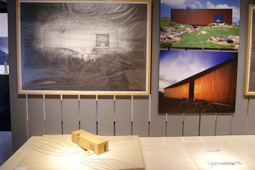 |
|
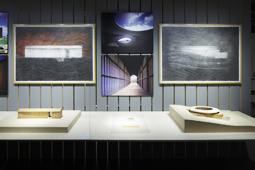 |
Conceived from local legends, the Museums of Stone (left photo), Wind, and Water (2006) on the Korean island of Jeju exhibit no artworks but rather are designed to showcase their namesakes -- drawing the visitor closer to nature and serving as places of spiritual repose. The architecture itself is the art, serving as both medium and message.
Right photo: © Nacása & Partners Inc. |
Through June 23, TOTO Gallery Ma in Tokyo presents Vestigial Impressions, the first exhibition in Japan to showcase the work of architect Jun Itami, who passed away in June 2011 leaving a 40-year legacy of artistic designs in Japan and Korea.
The retrospective introduces, via the customary scale models and photographs, two dozen works ranging from Itami's 1971 "Mother's House" debut to a posthumous project now underway in Korea. But its spiritual center is found in the drawings and sketches on display: some doodled on the odd memo leaf, newspaper page, or sheet of hotel stationery; others done in poetic brushstrokes of India ink; still more rendered meticulously in graphite and hung on the walls like so many works of art. It seems Itami's hands were never at rest -- a point that's driven home in the fourth-floor gallery, where the entire surface of a six-meter table is covered with his carefully preserved hand-drawn visions.
Itami once wrote, "There's a magical moment in drawing when, having grappled with amorphous ideas about a structure's shape, contours, and proportions, one moves beyond the discipline of esquisse to encounter some new, original, and deeply rooted proto-form -- you might call it the building's soul. Once I capture that pure essence clearly on paper, I begin the task of expressing it as architecture."
 |
|
 |
The third-floor gallery features Itami's works in Korea from 1998 onward. The display paneling in the left photo is modeled after the open-slatted exterior wall of the Museum of Wind (2006). The wooden object at right, hand-hewn by Itami, was a study for his sculpture that stands in the courtyard of the Ophel Golf Club House (2008) in Yeongcheon.
Left photo: © Nacása & Partners Inc. |
Itami was dedicated to the craft of architecture -- the considered sketch, the well-placed stone, the stark beauty of an unfinished sheet of metal. But an inquiry into his style soon turns into a study of the man's identity, because he viewed art and design as vehicles for personal growth. Born in Tokyo to Korean parents in 1937 (a time when Japan occupied Korea) and educated in Japanese schools through the completion of his architectural degree at Musashi Institute of Technology in 1964, Itami began to explore his Korean roots in his thirties through the study of that culture's traditional arts, in particular Joseon-dynasty ceramics -- a subject on which he became a foremost scholar. Although most of his early architectural works were built in Japan, it wasn't until he reached his late sixties that he gained notoriety here. His later projects in Korea on the resort island of Jeju, and accolades such as France's Order of Arts and Letters (Chevalier) in 2005, finally brought him long-overdue acclaim in Japan's architectural circles.
The first museum to feature Itami's work was the Musée Guimet in Paris. Its 2003 exhibition Itami Jun, Japan's Korean Architect addressed in its matter-of-fact title a lifelong irony of circumstance: in Japan, where he was born and raised, and whose language was his mother tongue, Itami was seen as Korean; in Korea, the land of his ancestors and where his own children were raised, he was considered Japanese. "At one point I realized that unless I dared to face my identity," he recalled in an interview, "I would never arrive at the core of who I am. So I broke the mirror that reflected me. By going to Korea, and through my study of eastern philosophies, I broke that mirror and saw myself in these myriad smaller fragments. In piecing them together again I found my own approach to life, to art, and to my brand of architecture." It's a style marked by a natural wildness, yet imbued with the warmth of someone who has weathered a great deal of introspection.
 |
|
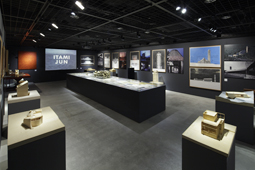 |
The courtyard linking the third- and fourth-floor galleries has been made into a contemplative water-and-rock garden with a view of Itami's Guest House for the Podo Hotel (2001), whose undulating roof echoes the natural features of Jeju's Mt. Sanbang in the distance. Inside, the fourth-floor space highlights the architect's early works in a setting that recalls the rich black interior of his Tokyo atelier, India Ink House (1975).
Right photo: © Nacása & Partners Inc. |
As a young architect Itami was strongly influenced by the Mono-ha artists of the late 1960s and early '70s, who treated materials and things as they are, raw and undisguised, seeking artistic merit through meaningful juxtapositions and relational nuances. Throughout his career Itami remained focused on unadulterated natural materials -- wood, earth, metals, stone -- and their contextual significance to the site. He called these fundamental elements "mediums of nothingness," which, like the splintered fragments of that broken mirror, in his hands found new form and meaning in designs that have retained their authenticity across the span of time. His works are often likened to sculpture, as much for their integrity of material as for their one-off originality.
Itami also embraced the aesthetic tradition outlined in Jun'ichiro Tanizaki's In Praise of Shadows -- a quiet, unpretentious sense of beauty that delights in "pensive lusters," "smoky patinas," and colors that "call to mind the past that made them." Like Tanizaki, Itami found beauty "not in the thing itself but in the patterns of shadows, the light and the darkness, that one thing against another creates."
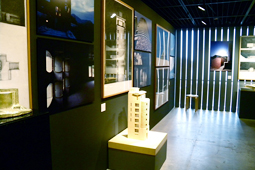 |
|
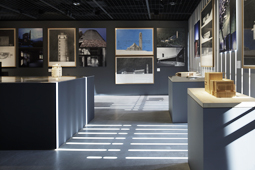 |
The choice of black to define the fourth-floor gallery is less a note of mourning than a tribute to Itami's championing of the Asian design aesthetic extolled by Jun'ichiro Tanizaki. The Museum of Wind (2006) is referenced here in the rhythmic way the installation admits natural light.
Right photo: © Nacása & Partners Inc. |
If Itami's designs bear features of emptiness and purity more typically associated with religious buildings, that's because he saw our experience of space as a means of training our minds away from extraneous phenomena toward nature and inner truths. The ridge of a mountain and the line of a roof echoing it give definition to a locality's identity; at the same time they are traces that we follow in pursuit of ourselves as observers, dwellers, or wanderers passing through in search of the next, higher solution. "The real measure of a space," Itami wrote, "lies not in its function but in its ability to evoke a feeling of vitality simply by one's being there."
Architects Yoo Ehwa, Itami's daughter and Seoul-based collaborator, and Toshiharu Tanaka, head of design at Itami Jun Architects in Tokyo, oversaw the installation design for this exhibition. Incorporating the play of light and water, the sound of Itami's voice, the materials he loved, and even the smell of paint, it is a sensory reminder of the reach of a single person's life, and a loving tribute to a father, mentor, colleague, and artist.
 |
|
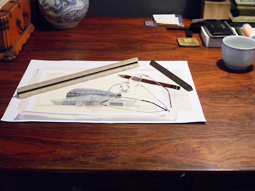 |
Colorful sketches and a transparent tank of miniature models reveal the inspirations, ideas, and relentless study that were the wellspring of Itami's designs. Also on exhibit are a film interview, oil paintings, and a favored rosewood desk, on which rests a drawing he was working on just before his death.
All images are by permission of, or are provided by, TOTO Gallery Ma. Unless otherwise indicated, photos are
© Susan Rogers Chikuba. |
|